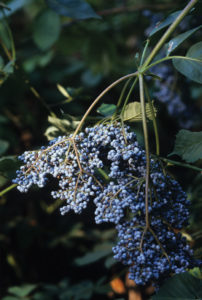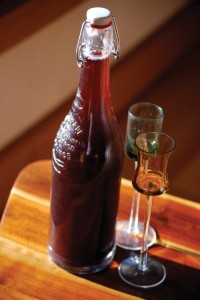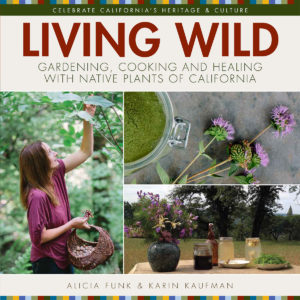Elderberry
HONEYSUCKLE FAMILY
Blue Elderberry Sambucus nigra subspecies caerulea syn. Sambucus mexicana
Red Elderberry Sambucus racemosa var. racemosa
Habitat & Elevation
Blue Elderberry: open habitats below 10,000′
Red Elderberry: moist areas 6,000′ – 11,000′
Collection Flower, Berry: summer
CAUTION If eating the berries, strain out the seeds and use only the cooked blue berries of Sambucus nigra subspecies caerulea in moderation, due to the hydrocyanic acid within Elderberry which can cause laxative effects. Avoid raw berries and Red Elderberry, Sambucus racemosa, whether cooked or raw.
Indigenous Names Mountain Maidu lokum hini*, nokomhyni; Nisenan nok
![]()
Blue Elderberry Sambucus nigra subspecies caerulea syn. Sambucus mexicana
Plant type Deciduous shrub or small tree
Size 10′ – 25’x10′ – 25′
Light Full sun to partial shade
Water Drought tolerant to moderate
Zone 6 to 10
Wild looking in its natural state, the Blue Elderberry is a fastgrowing, multi-trunked large shrub or small tree that with pruning can be trained into a more garden-appropriate plant. The leaves are divided into 1″ – 6″ long toothed leaflets. Large clusters of creamy white flowers occur in spring and summer, followed by dense clusters of blue to black berries. The flowers and berries attract bees and an amazing number of birds and other wildlife.[18]
Blue Elderberry tolerates many types of soil conditions and is relatively easy to grow. Plants in full sun produce more flowers and berries than those in shady conditions. It is drought tolerant, but holds its leaves longer and looks better with moderate summer irrigation. Hard pruning each winter will keep Blue Elderberry manageable and attractive. It is best planted in an area with enough space to fill out, but plants that have grown out of control can be cut back to the ground.[25] It is useful in the garden setting as a screen or windbreak.
Used often in revegetation projects for its wildlife and habitat value, Blue Elderberry is protected in California’s Central Valley because it is the host plant to the Valley Elderberry Longhorn Beetle, which is listed as a federally threatened species.
![]()
Elderberry Wine *Makes 5 gallons. Ready to drink in 1 year.
- 6 gallon pot
- 6 gallon bucket with airlock (primary fermentation device)
- 6 gallon glass carboy
- Iodine (for sterilizing)
- Candy thermometer
- Flip top bottles or wine bottles with corks and corker
- 4 feet of ½” transparent siphon hose
- 4 gallons of water
- 3 gallons of Elderberries (remove the stalks)
- 8 lbs sugar?
- 1 packet dry wine yeast
METHOD
- Remove the Elderberries from the stalks using a fork.
- Bring 4 gallons of water to a boil in a pot.
- Turn off heat. Stir in sugar until dissolved and then add berries.
- Cover and let cool to 70o.
- Pour into 6 gallon bucket and stir in yeast.
- Cover with lid slightly ajar and store for 3 days.
- Cap with airlock and let the airlock bubble and ferment for approximately 10 days.
- Siphon into glass carboy, avoiding the yeast and fruit that has settled on the bottom.
- Store at 65 – 70o (away from direct sunlight) for 2 months and then move to a cooler location (concrete floor in garage, basement, pantry) for 6 – 9 months. Over time, the bubbling will slow and then completely cease.
- Sterilize bottles with iodine, and bottle using corker or flip tops.
- For optimal flavor, wait 1 year before enjoying. For long-term storage of more than 2 years, store in wine bottles with corks.[68]
TIP Try a flavorful combination of Elderberry and native Blackberry by using 2 gallons Elderberries and 1 gallon Blackberries.
Elderberry Jam
CAUTION Strain out seeds and use only the cooked blue berries of Sambucus nigra subspecies caerulea in moderation, due to the hydrocyanic acid within Elderberry which can cause laxative effects. Avoid raw berries and Red Elderberry, Sambucus racemosa, whether cooked or raw.
- 3 lbs Elderberries
- 1 lemon
- 1 package liquid pectin
- 4 cups sugar
METHOD
- Remove stems and mash Elderberries.
- Cover with water and simmer for 15 minutes.
- Strain berries through cheesecloth and save liquid.
- Add lemon and pectin to liquid and bring to a boil for 1 minute, stirring constantly.
- Add sugar and boil for 2 minutes, stirring constantly.[3]
Elderberry Bread
- 3¾ cups rye flour
- 1 1/3 cups flour (wheat, Oak nut, or gluten-free substitute)
- 5 tbsp ground flax seeds
- 1 tsp baking soda
- ½ tsp salt
- 3¼ cups apple juice
- 2 tbsp lemon juice
- 2 tbsp vegetable oil
- 2 cups Elderberries
- 1 cup ground Toyon, Manzanita or Madrone berries
- 1 cup raw sunflower seeds
- 1 cup shredded coconut
METHOD
- Preheat oven to 350o.
- Mix dry ingredients in large bowl.
- Combine wet ingredients together.
- Gradually add wet ingredients into the dry.
- Add the Elderberries, ground wild berries, seeds and coconut without over mixing.
- Press into 2 oiled bread pans and sprinkle with cinnamon.
- Bake for about 1 hour.[34]
CAUTION Strain out seeds and use only the cooked blue berries of Sambucus nigra subspecies caerulea in moderation, due to the hydrocyanic acid within Elderberry which can cause laxative effects. Avoid raw berries and Red Elderberry, Sambucus racemosa, whether cooked or raw.
DRIED/COOKED
- The Maidu dried the berries before eating.[48]
![]()
Colds, Coughs and Sore Throats (Sambucus species)
Elderberry : The Diegueño, Coast Miwok, Kashaya, Cahuilla and Yuki Indians used the blossoms of Elderberry as a tea to treat fevers, colds and chest congestion.[33] Modern laboratory studies have confirmed the anti-viral effects and demonstrated a high content of Vitamin C in the berries.[14] Elderberry fruit (Sambucus nigra): Elderberry liquid extracts and juice concentrates have been clinically tested in patients with flu symptoms.[79, 80]
Fever (Sambucus species)
Make a tea by pouring hot water over the dried flowers and letting them steep for at least 20 minutes, according to Maidu Indian tradition as well as the British Herbal Compendium and the German Standard License which indicate the use of their native Black Elderflower, Sambucus nigra.[48, 52] Drink Elderflower tea from (3 – 5 g in 150 ml of water), 3 times per day.[52]
Wounds (Sambucus nigra subspecies caerulea)
Make a tea out of Blue Elderberry flowers to use as an antiseptic skin wash.[48]
![]()
Hunting Tools
Maidu Indians used branches of Sambucus species to make arrow shafts, atlatl spear shafts, fire drills and salmon spear toggles (the part of the spear that lodges in the fish).[48]






